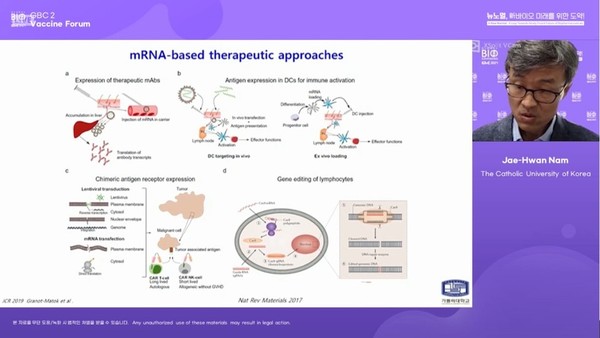Messenger RNA (mRNA) emerged as a next-generation biopharmaceutical technology, as it is expected to prevent and treat various types of diseases.
However, rather than rushing to develop mRNA vaccines as researchers have recently done to fight Covid-19, researchers should consider “many factors” from now on, an expert said.

Nam Jae-hwan, a professor of biotechnology at the Catholic University of Korea, attended the 2021 Global Bio Conference (GBC) on Tuesday and shared the history of the technological development of mRNA vaccines. He also explained issues to consider when developing an mRNA vaccine.
mRNA vaccine technology first appeared in the 1980s. A protein is expressed, purified, formulated, and used as a vaccine against a specific pathogen using the technology.
This technology has not been developed for a while but was first approved in 2020.
While a vaccine against a particular pathogen usually takes 10 to 100 years to develop, mRNA vaccines take less than a year.
Researchers analyzed the Covid-19 virus’ sequence on Jan. 12, 2020, and phase 1 and phase 2 trials began in March and May, respectively. In December 2020, mRNA vaccines by Moderna and Pfizer/BioNTech received approval for emergency use.
Professor Nam cited the use of lipid nanoparticles (LNP) as a delivery system for an mRNA expression platform as one of the most significant milestones in developing mRNA vaccines. This is because researchers’ top priority in an mRNA vaccine development was to optimize the stability.
Previously, the most used vehicle in drug delivery was dendritic cells.
“Since mRNA is a very fragile molecule, negatively charged, and large in size, delivery is difficult,” Nam said. “The mRNA transporter has two opposing functions – outside the cell, the mRNA must be protected, but inside the cell, the coated lipid should peel off easily.”
TriLink’s mRNA capping technology, called CleanCap, has been developed and protected as a patent.
However, LNP is not the only carrier of mRNA vaccine. Nam advised that other delivery systems such as lipoplex using liposomes and small peptides should be studied continuously.
One of the many things to consider for research of mRNA vaccine mechanism is the injection route, Nam went on to say. All authorized mRNA vaccines are intramuscular injections.
Although there were some differences in immune response between intramuscular and subcutaneous injections, the advantages and disadvantages of each injection method did not show clearly, he said.
“If it is a prophylactic mRNA vaccine, it is right to choose the easy administration method. That is why people prefer intramuscular injections,” he said.
Depending on the purpose of an mRNA vaccine, the injection method can change, and in this case, the size of the LNP should be adjusted, he explained.
Also, an mRNA vaccine developer should review related regulations, Nam emphasized.
Regulatory guidelines have yet to be published in detail, but the WHO provided a brief guideline in December 2020 and updated it in April 2021.
“This means that if you develop an mRNA vaccine, you have to consider this from the beginning,” he said.
Nam cautioned against excessive optimism on mRNA vaccine technology.
When he started studying mRNA vaccines six years ago, he thought it could be a game-changer.
However, as mRNA research expanded and emerged, his thoughts have changed a little, he said.
“mRNA vaccines are sometimes right and sometimes wrong. Replacing an existing vaccine with an mRNA vaccine is more difficult than people thought,” Nam said.
In the mRNA area, researchers from various fields must work together, he said.
He added that specialists in organic chemistry for delivery, molecular biology for platform, immunology, and virology should work together to develop an mRNA vaccine successfully.

